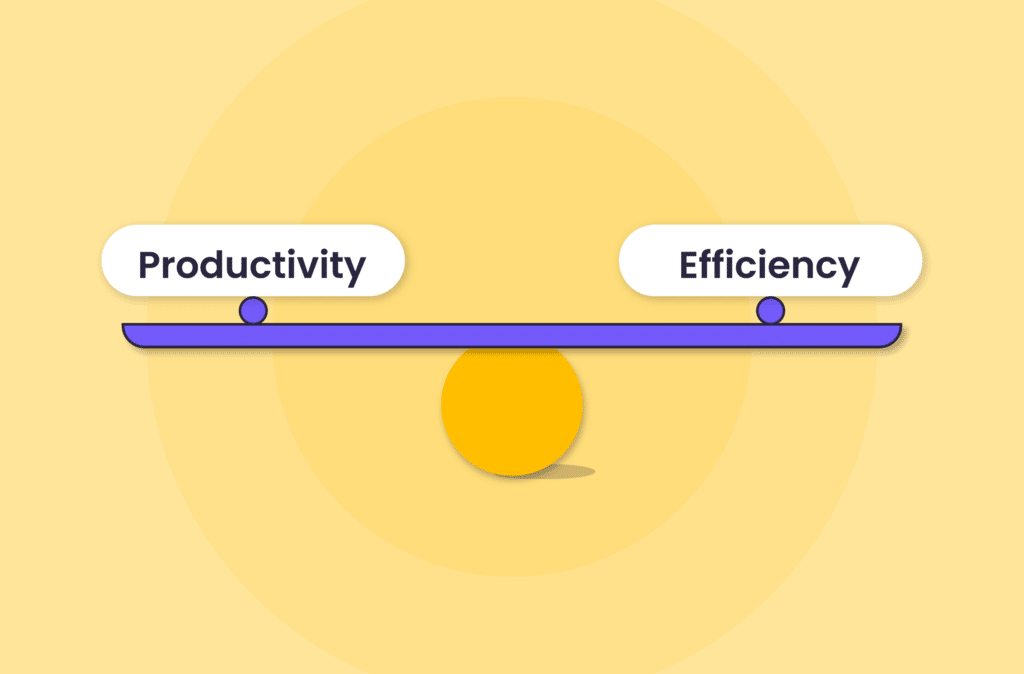Productivity and efficiency sound like two sides of the same coin. But they aren’t. In fact, prioritizing productivity vs efficiency is a bottleneck for managers across various industries.
If increasing productivity is one of your company’s priorities, you might want to rethink your strategy. In this article, we will cover exactly what both productivity and efficiency are. Moreover, you will learn how to measure productivity vs efficiency while maximizing output.
Ready? Let’s get to business.
Understanding Productivity vs Efficiency
Let’s say your team feels inspired on Monday. They get a lot done – writing code, setting up campaigns, running client meetings. They kill 15 labor hours in total. But, on Friday, you realize their output isn’t giving results. Productivity refers to the number of hours put into work, but not all of them are necessarily as efficient.
Many companies try to increase productivity without understanding how to inspire efficient teamwork.
What is Productivity?
Productivity measures how much work gets done in a given period. It’s about volume — how many projects, products, or deliverables you complete.
For example, a call center may aim to process 1,000 calls per day. If every agent meets their quota, the team is productive. But productivity alone doesn’t guarantee success if customers leave unhappy because of rushed conversations.
Think of productivity as getting more done in less time. It’s about output — whether that’s sending emails, finishing reports, or assembling products.
Productivity-driven manager asks the following questions:
How many tasks did you complete?
How much product did you deliver?
How quickly did you finish?
But getting a lot done doesn’t always mean doing it well.

What is Efficiency?
Efficiency refers to how well the same resources are used to achieve the same result.
To allocate resources efficiently means to streamline operations and delegate tasks. Efficient resource management leads to high-quality results – getting the job done with fewer resources invested.
For example, instead of maximizing productivity, you can decide to prioritize. Delegate high-impact tasks first, and check that they are done well. This means your team will invest most of their energy in core operations first.
That’s efficiency — doing things right. It’s not just about working fast but making every effort count.
If your priority is increasing efficiency, you should focus on:
Using fewer resources to achieve the same output
Eliminating unnecessary steps
Producing high-quality results
The Difference Between Efficiency and Productivity
While productivity measures how much gets done, efficiency measures how well it’s done. You can be highly productive but inefficient. Think of a sales team that makes 100 cold calls without generating any new leads.
Both productivity and efficiency matter. You want to deliver as much as possible, but not at the cost of wasted resources or poor outcomes.
The trick is to intentionally couple productivity and efficiency. This means efficient usage of all your resources and smart time management.

Key Distinctions – Comparison Table
The distinction? Productivity measures how much you do. Efficiency measures how well you do it.
| Productivity | Efficiency |
Priority | Maximizing the amount of work done within a timeframe | Minimizing waste and using resources in the best way possible |
Best for | When you need to complete a high volume of tasks or hit quotas | When quality is crucial and resources are limited |
Questions asked | How much did we accomplish and how fast did we get it done? | Did we achieve optimal results? |
Focus | Quantity — getting more done | Quality — doing tasks the right way |
Goal | Deliver as many outputs as possible | Deliver high-quality outputs with minimal resources (for half the cost) |
Measurement | Number of completed tasks, items produced, or hours worked | Resources used per unit or quality of results |
Approach | High-speed, task-focused | Process-optimized, resource-conscious |
Success indicator | Volume of output achieved | Level of resources conserved and quality maintained |
Ideal tool | Task and time-tracking tools (e.g., WebWork Time Tracker for monitoring task completion) | Process improvement tools (e.g., automation software to eliminate redundant steps) |
Challenges | Can lead to rushed work and errors if the quality is overlooked | May result in lower output volume if too much time is spent optimizing |
Productivity Fundamentals
Now that we know what productivity refers to, let’s learn how to use productivity formula and assess productivity planning.

Productivity Formula
The formula for productivity is Productivity = Output / Input
One of the most important metrics for measuring productivity is KPIs (key performance indicators). These indicators help you understand how fast your company is growing and how often you meet your goals.
For a software development company, this could mean measuring the number of features completed relative to the hours spent.
For example, if a company completes 25 features or fixes bugs valued at $50,000 using 1,000 developer hours, the productivity calculation looks like this:
50,000 / 1,000 = 50 output units per labor hour
In this context, “output” can represent deliverables like completed features, resolved bugs, or released versions. This formula shows how much value is generated per hour of development time.
Productivity Focuses
When you focus on productivity, you can go about it in two ways:
More output with the same resources – You want to increase production without new hires or a bigger budget.
Optimizing resources – Productivity isn’t just about speed. It’s about leveraging technology, processes, and people to deliver more within the same timeframe.
Let’s say a software development team is using WebWork Time Tracker. The app helps them realize that developers spend too much time in meetings. They adjust their schedule, limit meetings, and focus more on coding. The result? Faster project delivery.

Efficiency Formula and Strategies
General efficiency formula goes like this: Efficiency (%) = (Actual Output / Expected Output) × 100
Suppose a software development team is expected to complete 10 feature implementations in a week. This estimate is based on available resources (developer hours, project estimates). If they complete 8 features, we can calculate efficiency as follows:
Efficiency = (8 / 10) × 100 = 80%
By calculating efficiency, you learned that the team was achieving 80% of the planned output with the given resources. This means they operated at 80% efficiency.

Efficiency strategies
Efficiency strategies aim to improve processes and achieve better results with smaller investments.
Here are some efficiency examples:
Automating repetitive tasks – A marketing agency uses automation tools to send email campaigns, saving hours on manual work.
Streamlining processes – A logistics company eliminates unnecessary steps in order processing, reducing delivery times by 20%.
Optimizing team resources – A business restructures its teams to ensure each member focuses on high-value tasks, leading to improved project outcomes.
Efficiency is about focusing efforts on what matters most and maximizing quality.

Balancing Productivity and Efficiency
Productivity and efficiency are not the opposite concepts. Moreover, they both deserve a high place in your business strategy. The key is the optimize your processes and find the perfect balance – prioritize smarter and adjust accordingly.
It’s not as much about productivity vs efficiency. Productivity and efficiency go hand in hand, when you plan and measure them adequately.
Creating an Optimal Strategy for Your Business
A successful business finds the sweet spot between quantity and quality. Producing more without focusing on quality can result in rework, delays, and customer dissatisfaction.
Let’s see how a consulting firm tracked billable hours using WebWork Time Tracker. Initially, the team focused on logging the actual labor hours. Their aim was to increase the number of hours and bill more to their clients. The result of this strategy was obvious – the clients were not satisfied.
Based on that feedback, the firm has adjusted its approach. Now, instead of focusing on logging more hours, their primary focus is delivering meaningful client outcomes. Initially, they reduced the hours they spent on unnecessary tasks. This led them to bill smaller numbers to their client.
But client satisfaction improved, as well as retention. In the long run, they had saved a valuable client.
To wrap up this efficiency example, finding balance means two things:
Tracking both output and quality – Use tools to monitor how much work gets done and the impact it delivers.
Focusing on outcomes, not just activities – Make sure the tasks contribute to business goals.

Improving Productivity
The previous example was also a good productivity example. High productivity is not useful if it’s just raw productivity and doesn’t bring results. To begin improving your team operations, track productivity and discover bottlenecks to optimize.
However, make sure not to prioritize productivity vs efficiency. Quality shouldn’t suffer as you scale.
Tips for Businesses
Here are actionable ways businesses can boost productivity:
Set clear goals – Break large projects into smaller, achievable milestones.
Use time-tracking tools – Tools like WebWork Time Tracker help monitor time spent on each task, identifying bottlenecks.
Eliminate distractions – Avoid multitasking. Encourage employees to focus on one task at a time.
Reward progress – Recognize and celebrate milestones to keep the team motivated.

How to Improve Productivity
Improving productivity isn’t just about working faster—it’s about working smarter.
Identify waste – Look for repetitive tasks that can be automated.
Monitor progress – Use time-tracking software to analyze how time is allocated.
Reallocate resources – Focus your team’s efforts on high-impact tasks.
Bottleneck: A small SaaS startup found that their developers spent too much time on customer support. By hiring a dedicated support team, the developers could focus fully on product updates.
Conclusion
Productivity and efficiency are essential metrics for business success. While productivity measures how much work gets done, efficiency focuses on the quality and impact of that work.
To optimize workflows, businesses must strike a balance between both. Use WebWork Time Tracker to monitor productivity and ensure your efforts are aligned with business goals. With the right tools and strategies, your business can achieve more with less — delivering both quantity and quality in every project.
Ready to find your balance? Start using WebWork Time Tracker today to optimize productivity without sacrificing quality.
FAQs
Is it better to be efficient or productive?
Being efficient helps you use resources wisely, which often leads to better productivity. For example, a team that streamlines its coding process may complete projects faster without wasting time on unnecessary steps. On the other hand, being productive without efficiency might mean completing a lot but with higher costs or wasted time.
What is the difference between team efficiency and productivity?
Productivity is about quantity — how much work gets done in a given time. Efficiency is about quality — how well resources are used to get that work done. For instance, if a team completes 10 projects in a week, they’re productive; but if they use minimal time and resources for each, they’re efficient, too.
Is productivity a measure of efficiency?
Productivity often reflects efficiency but focuses more on output. For example, a company might measure productivity by the number of software features completed, while efficiency looks at how well time and resources were managed to complete them.
Is high productivity possible if efficiency is low?
Yes, it’s possible to be highly productive even if efficiency is low, but quality can suffer. For example, a team might push out 20 tasks in a day by rushing, but if errors pile up, they’ll spend extra time fixing things later — lowering overall efficiency.
How to calculate productivity vs efficiency?
To calculate productivity, divide the total output by the input (such as hours worked). For example, if a developer completes 10 tasks in 40 hours, productivity is 10 tasks / 40 hours = 0.25 tasks per hour.
To calculate efficiency, divide the actual output by the expected output and multiply by 100 to get a percentage. If the developer was expected to complete 12 tasks but completed 10, efficiency is (10 / 12) × 100 = 83.3%.

